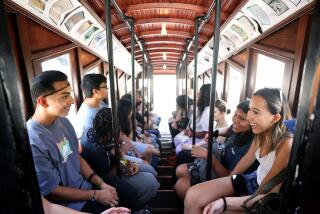AFTER THE RIOTS: THE SEARCH FOR ANSWERS : TV’s Hall Urges Students to Share Hopes and Fears
Outside Verbum Dei High School near Watts, the smell of smoke still hung faintly in the air at midday Friday and cleanup operations proceeded along Central Avenue. Only the navy blue stretch limousine and the television news vans parked in front of this well-regarded Catholic boys school hinted at what was going on inside.
For nearly an hour, talk show host Arsenio Hall, backed by a large panel of celebrities and civic leaders, encouraged 200 high school students from public and private schools all over the Los Angeles area to talk about the Rodney G. King beating case verdicts returned last week and the violence that ensued. The program was beamed live to 6 million students in 10,000 schools across the country that subscribe to Channel One, a controversial, commercial current events program at the center of a California court battle.
Friday’s program was the first large-scale, if not entirely successful, attempt to get high school students to talk openly about events of the last 10 days. Hall solicited comments from the racially mixed studio audience--assembled in the school’s gymnasium--and fielded questions by telephone from students as far as Michigan, New Jersey and South Carolina.
Hall asked an Asian-American student how the racially tinged violence made her feel.
“Afraid, disappointed, angered,” she replied. Then, sounding a theme that was to be echoed by many of her peers throughout the program, she added that she blamed “most of this on the media--they made it seem bigger than it was.”
In one of the show’s toughest moments, Hall asked whether any of the blacks in the audience felt Korean-American business owners should pull out of the traditionally black neighborhoods.
“I do,” said a young black woman, quietly but firmly. “They’re buying up everything. . . . We want to buy from our own people.”
But most of the students’ comments were more upbeat--heartfelt pleas for understanding among the races, pledges to help with the rebuilding efforts and vows to participate in elections so they can change the system.
“I think people are tired of being mistreated all over the world, not just black people,” said one young black man. “People have to start treating each other as equals.”
Actor Edward James Olmos, whose early efforts to organize volunteers for the cleanup have made him a familiar symbol of hope, told the audience that everyone has been taught racism in one form or another.
“The healing process has to start with the individual,” Olmos said to strong applause. “You’re the parents of tomorrow--you must not pass on racism to your kids.”
Other panelists were Shelby Steele, author of a provocative book on racism; Councilwoman Joan Milke Flores; attorney Angela Oh; Rep. Maxine Waters (D-Los Angeles); the Rev. Cecil Murray of the First African Methodist Episcopal Church; Ron Berkel of Boys’ Markets, and actor Sean Penn.
In a brief meeting with reporters after the telecast, Hall said that he believed “there was hope in that room” and that he thought the discussion was helpful. But he also said he “saw a lot of fear” and believed most students were hesitant to say what they really thought.
“Too many buildings burned for there to be that much peace in the room,” Hall said.
The 55-minute program represented a radical departure for the Channel One program, which has been widely criticized for pumping two minutes of commercials into its 10-minute daily segments. There were no commercials in Friday’s show except for the logos of Noxema and Clearasil.
Ironically, most Los Angeles students did not see the program Friday. Bill Honig, state superintendent of public instruction, has forbidden California public schools to subscribe to Channel One.
After the program, several of the students in the audience commented on its value.
“It was a good chance for us to give our opinions,” said Sandra Rodriguez. “It won’t solve anything, but at least it got us together.”
More to Read
Sign up for Essential California
The most important California stories and recommendations in your inbox every morning.
You may occasionally receive promotional content from the Los Angeles Times.











